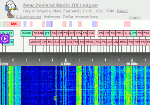
Then: Engineer David Andrews and technician Robert Oase are shown by the WWVB transmitter in 1963. Oase is relaying instructions to an engineer in a different location tuning the antenna.
Credit: NIST
Every day, electronic gear across the world locks on to a radio signal beamed from Fort Collins, Coloradio at the base of the Rocky Mountains in the USA. The signal contains a message that keeps the devices on time, helping to make sure their owners keep to their schedules and aren’t late for work the next day.
The broadcast comes from WWVB, a station run by the National Institute for Standards and Technology. WWVB marked half a century as the nation’s official time broadcaster on July 5. Together with its sister station, WWV, which is about to hit 90 years in service, the radio has been an invisible piece of American infrastructure that has advanced industries from entertainment to telecommunications.
(WWV’s broadcast includes a wider range of information, including maritime weather warnings and solar storm alerts). Most people aren’t even aware that these stations exist, but they have a rich and fascinating history. Their future is uncertain, however, as newer technologies threaten to make them obsolete.
Related articles:
More from the NIST web site.
The Most Important Radio Station You’ve Never Heard of Marks 50 Years on the Air



